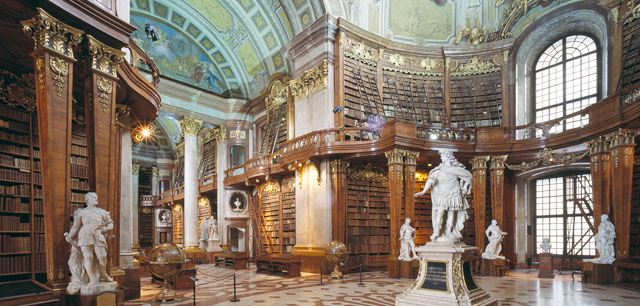Location
Josefsplatz 1, 1010 Vienna
oeffentlichkeitsarbeit@onb.ac.at
Opening Hours
Pomp and Circumstance: the baroque State Hall is one of the world’s most beautiful historical libraries. Emperor Charles VI (1685/1711-1740) ordered the construction of this jewel of secular baroque architecture for his Court Library. The State Hall was under construction from 1723 till 1726 according to plans of the famous court architect Johann Bernhard Fischer von Erlach and carried out by his son Joseph Emanuel. The frescoes on the ceiling were finished in 1730 by the court painter Daniel Gran.
The State Hall takes up the whole width of the Josefsplatz and measures a length of 77.7 m, a breadth of 14.2 m and a height of 19.6 m. Two sidewings and the cupola space give the hall a three-part structure. The frescoes in the entrance wing present worldly and war themes, while in the peace wing, bordering on the Hofburg, with the original entrance for the Emperor and his court, allegorical presentations of Heaven and peace are to be seen. The fresco in the cupola, just under 30 metres high, presents the apotheosis, i.e., the „divinisation“ of Charles VI, with an allegorical reference to the erection of the Library. The baroque governmental program for the fresco adornment was created by the courtly scholar Conrad Adolph von Albrecht (1682-1751). The four ornamental globes placed in the middle oval were the work of Vincenzo Coronelli (1650-1718). Together with the marble statues of the brothers Peter and Paul Strudel and the nutwood bookshelves they form an authentic picture of the baroque universal library of the 18th century.
Today the State Hall hosts 200,000 books from 1501 to 1850, among them the 15,000 volume collection of Prince Eugene of Savoy (1663-1736) in the middle oval. With its historic holdings and rooms the Austrian National Library is one of the world’s most important libraries.

